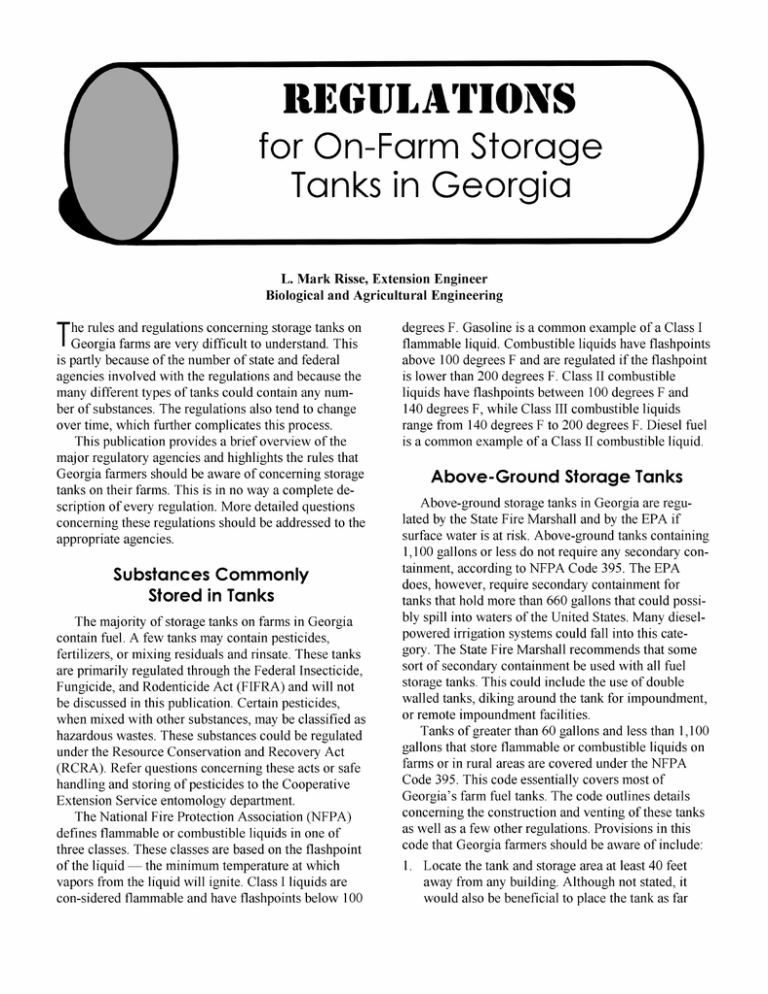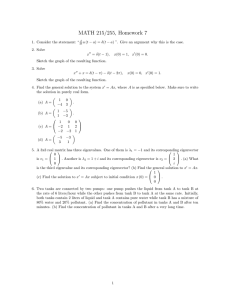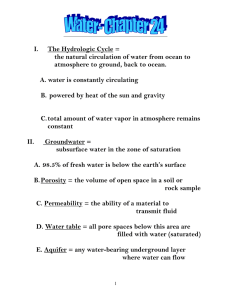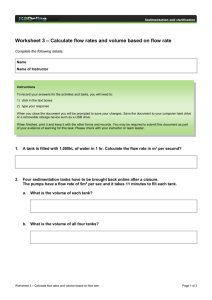Document 12947569
advertisement

The mission of the SPCC program is to promote and enforce measures designed to effectively prevent oil spills and contain those that occur before they reach any surface body of water. If a spill does occur, whatever the type of tank it is from, the EPA’s Clean Water Act requires that the National Response Center be notified immediately at 305-536-5651. For more information on the SPCC or spill prevention methods that could be beneficial to any farm, contact the United States EPA Emergency Response and Removal Branch. away from surface water, wells and property lines as possible. 2. Keep the storage area free of weeds and other combustible materials. 3. Conspicuously mark the tank with the name of the product it contains and “FLAMMABLE – KEEP FIRE AND FLAME AWAY.” 4. Support the bottom of the tank with concrete blocks approximately 6 inches above the ground surface to protect the bottom of the tank from corrosion. Underground Storage Tanks 5. If a pumping device is used, it should be tightly and permanently attached and meet NFPA approval. Gravity discharge tanks are acceptable, but they must be equipped with a valve that will automatically close in the event of a fire. Underground storage tanks are defined as containing more than 10 percent of their total volume beneath the soil surface. More than 22,000 facilities representing more than 48,000 underground storage tanks exist in Georgia. These tanks are regulated by the Georgia Department of Natural Resources Environmental Protection Division (EPD) under the Underground Storage Tank Act in Chapter 391-3-15. This act is an extension of the United States Environmental Protection Agency rules covered in Title 40 of the Code of Federal Regulations Part 280. The primary purpose of this act is to protect and enhance the quality of Georgia’s environment and protect public health and safety by instituting and maintaining a comprehensive statewide program for maintaining regulated substances stored in underground tanks. Underground tanks represent more of a problem than aboveground tanks because leaks can often go on for long periods of time without being detected. This poses a serious threat to ground water sources near the tank. While this act is quite comprehensive, a key provision was made to protect Georgia’s farmers. Farm or residential tanks of 1,100 gallons or less capacity and used for noncommercial purposes are exempt from the act. Underground tanks used to store heating oil for consumption on the premises are also exempt. This means that these types of underground tanks are unregulated unless they contain a hazardous or flammable substance, in which case they are covered under the Hazardous Waste Management Act, or NFPA 395. One final note concerning these exemptions: Underground tanks connected with piping systems are considered a single tank. Therefore, if two 750-gallon tanks are connected, the total volume would be 1,500 gallons, and the tanks would be subject to regulation. If an underground storage tank is covered under these regulations (holds more than 1,100 gallons), then the owner is required to register the tank with the EPD. They want the following information: 6. Submit plans for the installation of all storage tanks that will contain more than 60 gallons of Class I liquids or 120 gallons of Class II or Class III liquids to the State Fire Marshall for approval. 7. Report all tanks that catch on fire to the State Fire Marshall within 72 hours of the fire. Tanks that hold more than 1,100 gallons of combustible liquid are regulated under NFPA code 30. These tanks require secondary confinement in the form of dikes, secondary impoundments, or clay-lined holding areas. This code provides pertinent details on the fabrication, venting, location, monitoring and registration of these tanks and also information on allowable types of secondary containment systems. Anyone with tanks that fall into this category is strongly encouraged to obtain a copy of NFPA code 30 for review. Questions regarding Georgia above-ground storage tanks or information on registering new tanks may be referred to the State Fire Marshall at the Georgia Safety Fire Commissioner’s office. (Alan Shuman: Alan.Shuman @mail.oci.state.ga.us) One final category of tanks that fall under different jurisdiction includes tanks exceeding 660 gallons singly or groups of tanks with more than 1,320 gallons of total capacity that could pollute surface waters of the United States. These tanks are controlled by the EPA under the Spill Prevention, Control and Countermeasures Act (SPCC). This act only addresses tanks in which a spill of a total volume could be “reasonably expected” to reach any navigable body of surface water. It requires that tanks that meet both criteria prepare a spill prevention plan, implement spill prevention practices including secondary containment, and be liable for the damages caused as a result of any spill. 2 mitting additional paperwork regarding how you intend to close the tank and will require some soil and possibly ground water tests. The EPD has an excellent reference that answers many commonly asked questions concerning the closure of an underground storage tank: Closing Underground Storage Tanks – Brief Facts (Download the publication at http://www.epa.gov/swerust1/pubs/clo.pdf) For more information on closing underground tanks, contact Georgia EPD’s Underground Storage Tank Management Program. After discussing many of these regulations with each of the agencies involved, the general consensus is that none of these programs are specifically designed to target farm fuel tanks. While tanks that meet the criteria are expected to follow the regulations, the agencies will more than likely not be actively inspecting farm tanks. Nevertheless, the farmer or tank owner is liable in the event of a fire or spill, and he will be responsible for the damages associated with it. As little as 1 gallon of gas can contaminate as much as 2-10 million gallons of water, and cleanup from single tank spills typically cost $10,000 to $100,000. By observing safe practices and using common sense, most accidents can be avoided. If you are interested in finding out how you can avoid ground water contamination and potential liability, then contact the University of Georgia Extension Biological and Agricultural Engineering Department for an in-depth review of how you can prevent contamination from your fuel storage tanks. 1. Name and address of the facility where the underground storage tank is located. 2. Name and address of the owner/operator of the tank. 3. Size and identification of the storage tank. 4. Information on the substances to be stored in the tank. 5. Certification of financial responsibility in case of leaks or spills. In addition, these regulations will require the owner to: 1. Notify the EPD of changes in the tanks or substances held in the tanks. 2. Require a leak detection procedure depending on the type of tank. 3. Require the owner to notify the EPD within 24 hours of the detection of any leak. 4. Give the EPD the right to inspect the tank at any time if they reasonably believe that any violations are occurring. The appropriate paperwork for registering an underground storage tank may be obtained from the Georgia EPD’s underground tank division. (Visit their web site at http://www.epa.gov/swerust1/) If you have an underground storage tank and wish to avoid this annual process, or you have an underground storage tank that is no longer in use, you may want to permanently close this tank. This process is also regulated by the EPD. It essentially involves sub- 3 Bul l et i n1136 Revi ewedMay ,2009





